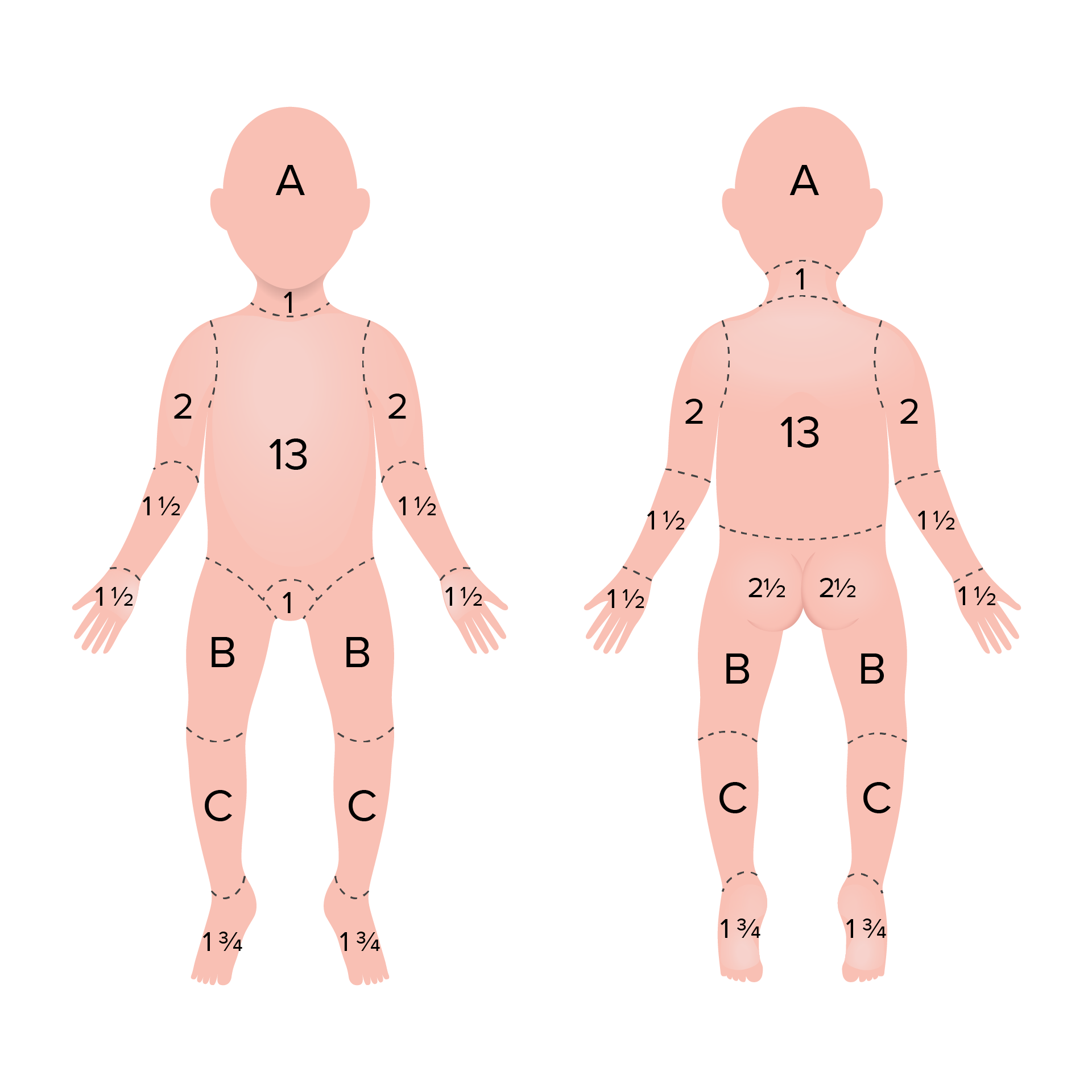Playlist
Show Playlist
Hide Playlist
Estimation of Total Body Surface Area (TBSA) & Calculation of Volume Resuscitation
-
Emergency Medicine Burns.pdf
-
Download Lecture Overview
00:01 How do we assess the surface area? There’s lots of different ways of doing it. 00:04 One commonly used one is the rule of nines which is really only valid for adults and that basically says that the head is 9%, the front of the torso is 9, the back of the torso’s another 9. 00:16 The front of the abdomen’s 9, the back of the lower back is another 9. 00:21 Each leg is 18, each arm is 9, it all adds up to a hundred but it’s actually not terribly reliable even though it is easy to remember especially at extremes of weight. 00:31 So very thin patients or very obese patients, this doesn’t really give you a good accurate assessment and there is a pediatric version available but because these proportions are so growth dependent, it’s not actually as accurate as we might hope. 00:47 So a little bit more sophisticated approach is the Lund-Browder Chart. 00:51 This is not one that you’re gonna be able to memorize. 00:54 So you would definitely have to pull this up and refer to it while you’re calculating surface area. 00:59 It’s definitely more complex than the rule of nines but it does address issues of relative growth for pediatric patients. 01:06 So it shows you visually how the body is broken down and then, it actually provides you with a chart based on the patient’s age that tells you, yeah, if you’ve got half the head involved and it’s a baby, it’s gonna be 9.5%, whereas if it’s a 15 year old, it’s gonna be 4.5%. 01:25 So it addresses the relative sizes of different body parts and different age ranges, and allows you to more accurately calculate the total percent burned. 01:34 The most commonly used one is the Parkland formula. 01:37 It’s based on lactated ringers and the calculation is 4cc per kilo per percent surface area burned. 01:46 You give half of that in the first 8 hours, and then, the other half over the next 16 hours. 01:52 Now, there have been a lot of studies looking at the Parkland formula and it actually results in over-resuscitation in a significant percentage of patients. 02:00 So you wanna be a little bit careful and make sure that you’re monitoring and titrating the patient’s fluid intake to their urine output. 02:10 A lot of times, people use the Modified Brooke formula which as you can see, is a little bit less aggressive. 02:15 It’s 2cc per kilo per percent burned for adults and 3% for children. 02:21 So it’s a little bit less than what Parkland gives Current Advanced trauma, life support and the American Bar Association guidelines both endorse the use of the modified Brooke formula. 02:32 However, the overall goal of fluid resuscitation is to titrate fluid input to urine output goals. 02:39 but in either case again, you wanna make sure that you’re carefully monitoring urine output. 02:44 We expect half a cc per kilo per hour for adults and between half a cc and one cc per kilo per hour for children. 02:53 If you’re getting significantly more urine output than that, you’re probably over resuscitating and wanna back off on your fluids a little bit. 03:00 So just adjust it so that you maintain the expected urine output over time. 03:05 So here’s an example just to go through the calculations for you. 03:08 We’ve got a 29-year-old man who got drunk and fell into a campfire. 03:12 He’s got burns over his entire anterior chest and abdomen, as well as his bilateral thighs, which gives us a roughly 27% total body surface area burn. 03:24 His weight is 80 kilos. 03:26 So by the Parkland formula, 4 cc per kilo times 80 kilos, times 27% burned gives us 8640 cc of lactated ringers. 03:40 Now, Parkland tells us to divide that in half. 03:42 We’re gonna give half of that in the first 8 hours. 03:45 So 4320 cc over 8 hours which is 540 cc an hour. 03:50 That’s a lot of fluid, right? That’s more than half a liter of fluid per hour. 03:55 So it’s a pretty significant volume. 03:56 The remainder, we’re gonna give in the next 16 hours and that’s gonna take us down to 270 cc per hour after the first 8 hours of resuscitation. 04:05 So let’s say our patient has 300 cc of urine output in a 2-hour period. 04:12 Well, he’s an 80 kilo guy, so we expect him to have half a cc per kilo per hour, or about 40 cc an hour. 04:21 He’s had 300 cc in 2 hours which is more than three times what we’d expect for him. 04:26 So this is a situation where we would wanna say, okay, we’ve gotten a little bit overzealous with our fluid. 04:32 Let’s back it down. 04:33 Let’s maybe cut it in half and reassess the urine output in a couple of hours to keep ourselves on track.
About the Lecture
The lecture Estimation of Total Body Surface Area (TBSA) & Calculation of Volume Resuscitation by Julianna Jung, MD, FACEP is from the course Toxicologic and Environmental Emergencies. It contains the following chapters:
- Estimation of TBSA
- Calculation of Volume Resuscitation
Included Quiz Questions
According to the Lund-Browder chart, what is the percentage of TBSA for a burn injury to the dorsal forearm?
- 1.5%
- 1%
- 2%
- 2.5%
- 3%
What is the calculation of volume resuscitation for the initial 24 hours in adults using the Modified-Brooke formula?
- 2cc / kg / %TBSA
- 3cc / kg / %TBSA
- 4cc / kg / %TBSA
- 1cc / kg / %TBSA
- 0.5cc / kg / hr
Customer reviews
5,0 of 5 stars
| 5 Stars |
|
5 |
| 4 Stars |
|
0 |
| 3 Stars |
|
0 |
| 2 Stars |
|
0 |
| 1 Star |
|
0 |




